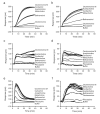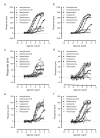Label-free cell phenotypic assessment of the biased agonism and efficacy of agonists at the endogenous muscarinic M3 receptors
- PMID: 23933114
- PMCID: PMC3858480
- DOI: 10.1016/j.vascn.2013.07.005
Label-free cell phenotypic assessment of the biased agonism and efficacy of agonists at the endogenous muscarinic M3 receptors
Abstract
Introduction: Efficacy describes the property of a ligand that enables the receptor to change its behavior towards the host cell, while biased agonism defines the ability of a ligand to differentially activate some of the vectorial pathways over others mediated through the receptor. However, little is known about the molecular basis defining the efficacy of ligands at G protein-coupled receptors. Here we characterize the biased agonism and cell phenotypic efficacy of seven agonists at the endogenous muscarinic M3 receptors in six different cell lines including HT-29, PC-3, HeLa, SF268, CCRF-CEM and HCT-15 cells.
Methods: Quantitative real-time PCR and multiple label-free whole cell dynamic mass redistribution (DMR) assays were used to determine the functional muscarinic receptors in each cell line. DMR pathway deconvolution assay was used to determine the pathway biased activity of the muscarinic agonists. Operational agonism model was used to quantify the pathway bias, while macro-kinetic data reported in literature was used to analyze the biochemical mechanism of action of these agonists.
Results: Quantitative real-time PCR and ligand pharmacology studies showed that all the native cell lines endogenously express functional M3 receptors. Furthermore, different agonists triggered distinct DMR signals in a specific cell line as well as in different cell lines. DMR pathway deconvolution using known G protein modulators revealed that the M3 receptor in all the six cell lines signals through multiple G protein-mediated pathways, and certain agonists display biased agonism in a cell line-dependent manner. The whole cell efficacy and potency of these agonists were found to be sensitive to the assay time as well as the cell background. Correlation analysis suggested that the whole cell efficacy of agonists is correlated well with their macro-dissociation rate constants.
Discussion: This study implicates that the endogenous M3 receptors are coupled to multiple pathways, and the muscarinic agonists can display distinct biased agonism and whole cell phenotypic efficacy.
Keywords: Biased agonism; DMR; Drug residence time; Dynamic mass redistribution; Efficacy; G protein-coupled receptor; GPCR; HBSS; Hanks' balanced salt solution; Muscarinic M(3) receptor; RT-PCR; RWG; dynamic mass redistribution; real time polymerase chain reaction; resonant waveguide grating.
© 2013.
Figures








Similar articles
-
Label-free cell phenotypic profiling and pathway deconvolution of neurotensin receptor-1.Pharmacol Res. 2016 Jun;108:39-45. doi: 10.1016/j.phrs.2016.04.018. Epub 2016 Apr 23. Pharmacol Res. 2016. PMID: 27117668
-
Non-invasive optical biosensor for assaying endogenous G protein-coupled receptors in adherent cells.J Pharmacol Toxicol Methods. 2007 May-Jun;55(3):314-22. doi: 10.1016/j.vascn.2006.11.001. Epub 2006 Nov 29. J Pharmacol Toxicol Methods. 2007. PMID: 17207642
-
Teaching an Old Drug New Tricks: Agonism, Antagonism, and Biased Signaling of Pilocarpine through M3 Muscarinic Acetylcholine Receptor.Mol Pharmacol. 2017 Nov;92(5):601-612. doi: 10.1124/mol.117.109678. Epub 2017 Sep 11. Mol Pharmacol. 2017. PMID: 28893976 Free PMC article.
-
Attributes novel drug candidate: Constitutive GPCR signal bias mediated by purinergic receptors.Pharmacol Ther. 2025 Mar;267:108802. doi: 10.1016/j.pharmthera.2025.108802. Epub 2025 Jan 23. Pharmacol Ther. 2025. PMID: 39862926 Review.
-
Contractile role of M2 and M3 muscarinic receptors in gastrointestinal smooth muscle.Life Sci. 1999;64(6-7):387-94. doi: 10.1016/s0024-3205(98)00584-0. Life Sci. 1999. PMID: 10069501 Review.
Cited by
-
Pharmacological profile of the neuropeptide S receptor: Dynamic mass redistribution studies.Pharmacol Res Perspect. 2018 Dec 3;6(6):e00445. doi: 10.1002/prp2.445. eCollection 2018 Dec. Pharmacol Res Perspect. 2018. PMID: 30534379 Free PMC article.
-
Label-free drug discovery.Front Pharmacol. 2014 Mar 27;5:52. doi: 10.3389/fphar.2014.00052. eCollection 2014. Front Pharmacol. 2014. PMID: 24723889 Free PMC article. Review.
-
Identifying ligand-specific signalling within biased responses: focus on δ opioid receptor ligands.Br J Pharmacol. 2015 Jan;172(2):435-48. doi: 10.1111/bph.12705. Epub 2014 Jul 1. Br J Pharmacol. 2015. PMID: 24665881 Free PMC article. Review.
-
Dynamic mass redistribution analysis of endogenous β-adrenergic receptor signaling in neonatal rat cardiac fibroblasts.Pharmacol Res Perspect. 2014 Feb;2(1):e00024. doi: 10.1002/prp2.24. Pharmacol Res Perspect. 2014. PMID: 24683488 Free PMC article.
-
NOP receptor pharmacological profile - A dynamic mass redistribution study.PLoS One. 2018 Aug 30;13(8):e0203021. doi: 10.1371/journal.pone.0203021. eCollection 2018. PLoS One. 2018. PMID: 30161182 Free PMC article.
References
-
- Black JW, Leff P. Operational models of pharmacological agonism. Proceedings of the Royal Society B: Biological Sciences. 1983;220:141–162. - PubMed
-
- Calebiro D, Nikolaev VO, Persani L, Lohse MJ. Signaling by internalized G-protein-coupled receptors. Trends in Pharmacological Sciences. 2010;31:221–228. - PubMed
-
- Casarosa P, Bouyssou T, Germeyer S, Schnapp A, Gantner F, Pieper M. Pre-clinical evaluation of long-acting muscarinic antagonists: comparison of tiotropium and investigational drugs. The Journal of Pharmacology and Experimental Therapeutics. 2009;330:660–668. - PubMed
-
- Caulfield MP, Birdsall NJ. International Union of Pharmacology. XVII. Classi-fication of muscarinic acetylcholine receptors. Pharmacological Reviews. 1998;50:279–290. - PubMed
Publication types
MeSH terms
Substances
Grants and funding
LinkOut - more resources
Full Text Sources
Other Literature Sources

